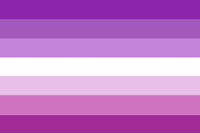m (Formatting) |
No edit summary Tag: Source edit |
||
| Line 46: | Line 46: | ||
[[es:Femme]] |
[[es:Femme]] |
||
| + | [[de:Femme]] |
||
Revision as of 13:42, 22 May 2022
Femme has many different meanings, and often refers to a person of queer gender expression that embraces, reclaims, or subverts their culture's understanding of what it means to be feminine.[1][2] Femme is often associated with the lesbian community, although it has also been used by bisexuals, gay men, and genderqueer people, among other groups.[1][3] It can describe gender presentation[4][5] on an occasion or be a term related to a person's gender identity. Some variations are "hard femme," an edgy or hard-rock expression of femininity, and "high femme", usually an extreme expression of the aesthetic aspects of femininity.[4]
Femme is often understood on a spectrum of butch to femme or stud to femme.[5]
| Stub | |
| This article is a stub. You can help LGBTQIA+ Wiki by expanding it. |
Community
History
In the United States, butch/femme roles were common in lesbian communities during the first half of the 20th century.[6]
Flag

The femme flag, made by Tumblr account noodle in 2017.
Some time after June 27, 2017, and before December 3rd, 2017, the Tumblr blog noodle posted a seven-striped femme flag design.[7] Purple was specifically chosen to match the vibrant orange of the butch flag. It also took inspiration from the pink and red lesbian flag.[7]
Perceptions and discrimination
Although working class butch/femme culture was not a simple imitation of heterosexuality, that assumption led to stereotyping and dismissal by many lesbian feminists, the medical establishment, and more affluent gays and lesbians. The dominant discourse of feminism and lesbian feminism in the 1970s and early 1980s regarded butch/femme communities as incompatible with feminism and marginalized them in lesbian history. From that perspective, butch/femme roles were criticized as reproducing patriarchy and hierarchies within women's relationships; they were not seen as being distinct, transformative, or a form of resistance to the oppression of women.[6]
Media
Literature
- The Persistent Desire: A Femme-Butch Reader by Joan Nestle
- S/He by Minnie Bruce Pratt
- Femme: Feminists, Lesbians, and Bad Girls by Laura Harris and Elizabeth Crocker
- My Dangerous Desires: A Queer Girl Dreaming Her Way Home by Amber L. Hollibaugh
Public figures
- Indya Moore
- Jonathan Van Ness
References
- ↑ 1.0 1.1 Davis, Jamie Geneve: "The Evolution of Femme: The Case for Femme as a Multifaceted Queer Identity". depaul.digication.com.
- ↑ Levitt, H.M.; Gerrish, E.A.; and Hiestand, K.R.. "The Misunderstood Gender: A Model of Modern Femme Identity". Sex Roles. 48, 99–113, 2003. (web archive)
- ↑ "Butch-Femme.com: GenderQueers". web.archive.org.
- ↑ 4.0 4.1 The Trans Language Primer: "Femme". The Trans Language Primer. (Archived on December 9, 2021).
- ↑ 5.0 5.1 PFLAG: "National Glossary of Terms". pflag.org. (Archived on January 25, 2022).
- ↑ 6.0 6.1 Kennedy, Elizabeth Lapovsky and Davis, Madeline D.. Boots of Leather, Slippers of Gold: The History of a Lesbian Community. 20th anniversary edition, Routledge (Taylor & Francis Group), 2014.
- ↑ 7.0 7.1 Tumblr user noodle: "An idea for a femme flag". wuvsbian.tumblr.com. (Archived version).
